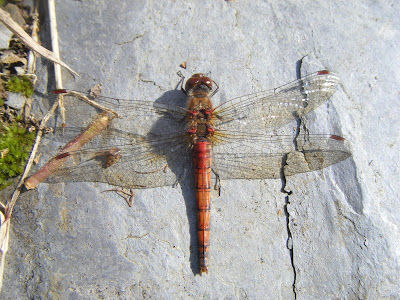The Orthoptera are the grasshoppers, groundhoppers and crickets. Twelve species are found in Ireland and regarded as native (1). Throughout the 19th and 20th centuries, a lack of attention was paid to Irish Orthoptera, with a few exceptions (2). Therefore the true extent of distribution of species may not reflected in the literature.
Irish Orthoptera Species
| Family |
Species |
Common Name |
Note |
| Tettigoniidae (Crickets) |
Conocephalus dorsalis |
Short Winged Cone Head |
First recorded in 1989 |
| Leptophyes punctatissima |
Speckled Bush Cricket |
Found in south |
| Meconema thallsainium |
Oak-Bush Cricket |
Found in south-west |
| Metrioptera roeselii |
Roesel's Bush Cricket |
First recorded in 1977 |
| Pholidoptera griseoaptera |
Dark Bush Cricket |
First recorded in 1983 |
| Tetrigidae (Groundhoppers) |
Tetrix undulata |
Common Ground Hopper |
Widespread |
| Tetrix subulata |
Slender Ground Hopper |
Restricted to Galway |
| Acrididae (Grasshoppers) |
Myrmeleotettix maculatus |
Mottled Grasshopper |
Widespread but local |
| Chorthippus brunneus |
Common Field Grasshopper |
Widespread |
| Chorthippus albomarginatus |
Lesser Marsh Grasshopper |
First recorded in 1960 |
| Omocestus viridulus |
Common Green Grasshopper |
Widespread |
| Stethophyma grossum |
Large Marsh Grasshopper |
Found in west |
Five species of grasshopper are present in Ireland (see table).
Chorthippus brunneus and
Omocestus viridulus are the most common, both being found in a variety of grassy places (3).
Myrmeleotettix maculatus prefers drier areas such as dunes and heaths and therefore tends to be more local. Ireland's largest grasshopper,
Stethophyma grossum, is locally restricted to floating acid bogs in the West of Ireland.
C. albomarginatus is the most recent addition to the Irish grasshoppers, with a first record in 1960 (2). It is restricted to a few site in the south-west, favouring grassland and dunes.
 |
| Common Green Grasshopper, Omocestus viridulus |
The grounhoppers are a family of orthopterans that resemble grasshoppers, but are much smaller in size. Unlike other Orthoptera, most groundhoppers overwinter as adults. Two species are present in Ireland.
Tetrix undulata is of widespread but local occurence.
T. subulata is similar in appearance, but has a longer protonum and wings and is restricted to Galway.
Crickets in Ireland are less common than grass- or groundhoppers. Five species of crickets are present in Ireland, with three of these being first recorded only in the last 34 years.
Leptophyes punctatissima can be found in hedgerows but is restricted to the local areas in the south of Ireland and quite scarce.
Meconema thallsainium is again restrcited to the south west of the country, favouring woodlands, but may also be seen sometimes in gardens. Found in damp meadows,
Metrioptera roeselii was first recorded in 1977 (2).
Pholidoptera griseoaptera was first recorded in Ireland in 1983 in the south east (4). it is found in in hedgerows and amongst scrub near sea cliffs and dunes. The most recent addition to the list of Irish orthopera is
Conocephalus dorsalis. This was recorded in 1989 in the south west prefers two distintct habitats: coastally on saltmarshes and sand dunes and inland on lowland bogs and fens.
 |
| Common Field Grasshopper, Chorthippus brunneus |
As well as frequent records of one-off species arriving on imported produce, three other orthoptera species of note have been recorded in Ireland. The European Mole Cricket,
Gryllotalpa gryllotalpa, was recorded in from one site in Northern Ireland pre 1970, but is not considered native. The non-native House Cricket
Acheta domesticus was present in Ireland until about 1960, but although recent sightings have been reported (5), it is now considered rare or absent. The Greenhouse Camel Cricket,
Tachycines asynamorus can be found as an introduced species in Ireland, but as it tends to become established in artificial situations such as greenhouses, it is not included in the Irish list of Orthoptera.
References:
- Ferriss et al., 2009. Irish Biodiversity: A Taxonomic Inventory of Fauna p. 108
- Haes and Harding, 1997. Atlas of grasshoppers, crickets and allied insects in Britain and Ireland
- Sterry, 2004. Collins Complete Guide to Irish Wildlife p. 124
- O'Connor and O'Connor, 1985. Entomologists' Gazette 36 pp. 229-232
- O'Connor, 1993. Irish Naturalists' Journal 24 p. 337


























